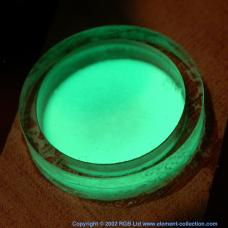Promethium(III) chloride
 Glowing powder mixture of promethium(III) chloride and zinc sulfide
| |
 Crystal structure
| |
| Names | |
|---|---|
| Other names
Promethium chloride; Promethium trichloride
| |
| Identifiers | |
3D model (
JSmol ) |
|
| ChemSpider | |
ECHA InfoCard
|
100.034.004 |
| EC Number |
|
PubChem CID
|
|
| |
| |
| Properties | |
| Cl3Pm | |
| Molar mass | 251 g·mol−1 |
| Density | 4.19 g/cm3 (calc., XRD)[1] |
| Melting point | 655 °C (1,211 °F; 928 K)[2] |
| Structure | |
Trigonal, hP8
| |
| P63/m, No. 176[1] | |
| Related compounds | |
Other anions
|
Promethium(III) oxide |
Other cations
|
Neodymium(III) chloride, Samarium(III) chloride |
Except where otherwise noted, data are given for materials in their standard state (at 25 °C [77 °F], 100 kPa).
| |
Promethium(III) chloride is a chemical compound of promethium and chlorine with the formula PmCl3. It is an ionic, water soluble, crystalline salt that glows in the dark with a pale blue or green light due to promethium's intense radioactivity.
Preparation
Promethium(III) chloride is obtained from promethium(III) oxide by heating it in a stream of dry HCl at 580 °C.[3]
Properties
Promethium(III) chloride is a purple solid with a melting point of 655 °C.[4] It crystallizes in the hexagonal crystal system (NdCl3 type) with the lattice parameters a = 739 pm and c = 421 pm with two formula units per unit cell and thus a calculated density of 4.19 g·cm−3.[5][6] When PmCl3 is heated in the presence of H2O, the pale pink colored promethium(III) oxychloride (PmOCl) is obtained.[5][7]
Applications
Promethium(III) chloride (with
References
- ^ S2CID 201840710.
- ISBN 1-4398-5511-0.
- Gmelins Handbuch der anorganischen Chemie, System No. 39, p. 61–62.
- ISBN 978-3-11-017770-1.
- ^ a b Weigel: Die Chemie des Promethiums, p. 588–589.
- Gmelins Handbuch der anorganischen Chemie, System No. 39, p. 181.
- Gmelins Handbuch der anorganischen Chemie, System No. 39, p. 31.
- ISBN 1-4398-5511-0.
- ^ Lavrukhina, Avgusta Konstantinovna; Pozdnyakov, Aleksandr Aleksandrovich (1966). Аналитическая химия технеция, прометия, астатина и франция [Analytical Chemistry of Technetium, Promethium, Astatine, and Francium] (in Russian). Nauka. p. 118.
